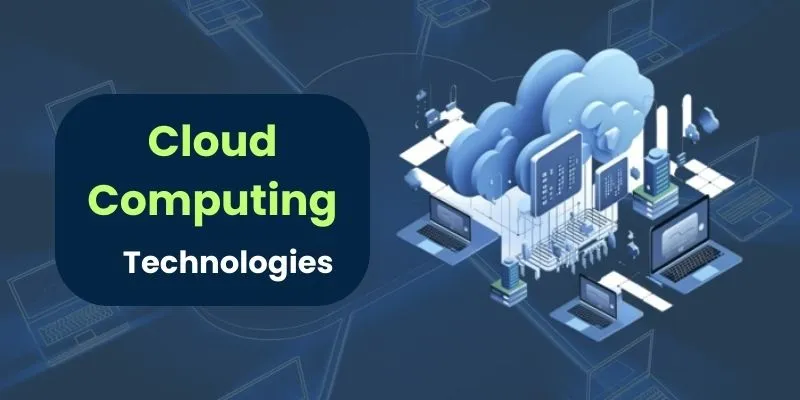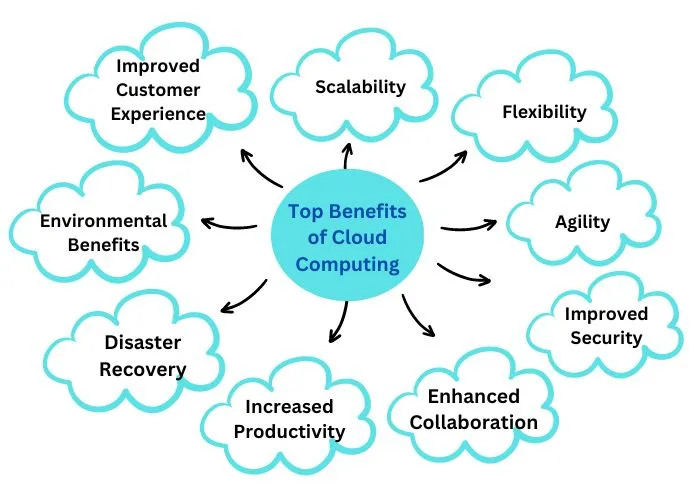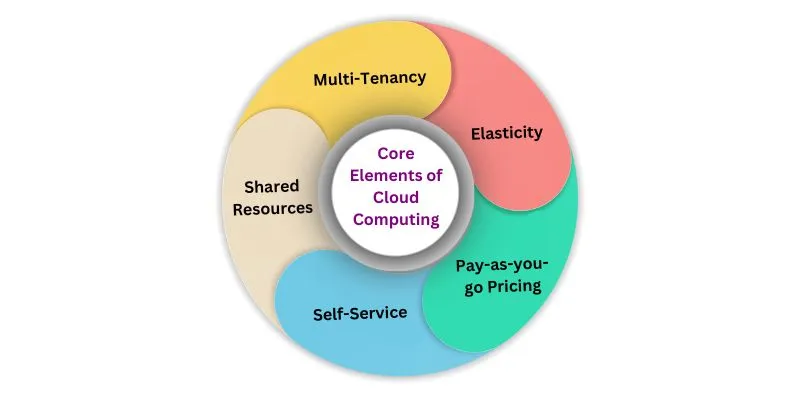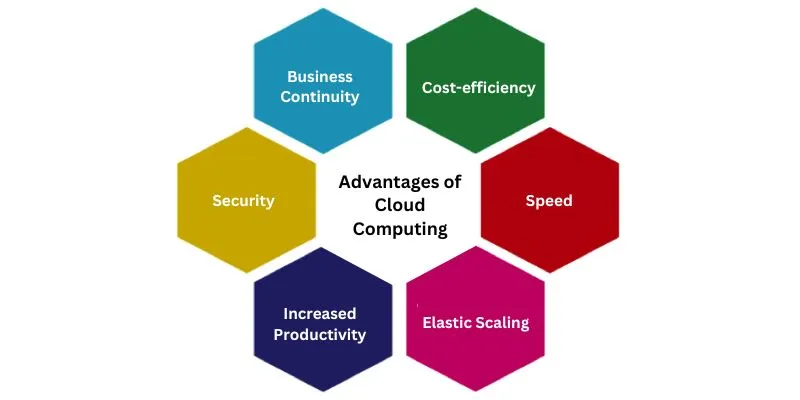
The discourse surrounding cloud computing has become ubiquitous in contemporary discussions, attracting attention from professionals and individuals familiar with the internet, despite not everyone possessing a precise understanding of its intricacies. In the following discussion, we will explore the concept of cloud computing, elucidating its definition, operational mechanisms, and anticipations for emerging cloud technologies in 2024. For individuals eager to delve deeper into the realm of cloud computing and stay abreast of emerging trends, considering enrolling in a reputable Cloud Computing Course in Coimbatore can provide valuable insights and skills. Through this training opportunity, people will gain the information necessary to manage the complexities of cloud computing and stay up to date on how cloud technology will change over the next several years.
To commence, let's revisit the fundamental definition of "cloud computing."
What is Cloud Computing?
Cloud computing entails the provision of on-demand IT services over the internet, encompassing analytics, databases, networking, servers, and storage. These virtual services offer advantages such as accelerated innovation, seamless scalability, and enhanced resource flexibility.
A distinctive feature of many cloud models is the pay-as-you-go pricing structure, enabling organizations to pay only for the resources they utilize. This cost-effective approach proves advantageous for integrating IT services into business operations without the need for substantial investments in an on-premises data center.
A variety of virtual services are included in noteworthy cloud technologies, such as Software as a Service (SaaS), Infrastructure as a Service (IaaS) and Platform as a Service (PaaS) Various solutions to meet various business objectives are provided by these technical frameworks., adding to the ever-changing environment of cloud computing.
Top Benefits of Cloud Computing
Cost Savings: One of the primary advantages of embracing cloud computing is its potential to reduce costs significantly. Businesses can forgo substantial investments in expensive on-premises hardware and software by opting for cloud-based applications and services, accessed through a cost-efficient pay-as-you-go model.

Scalability
Cloud computing stands out for its exceptional scalability, allowing businesses to effortlessly adjust their utilization of cloud-based resources in response to evolving needs. This flexibility ensures that organizations can efficiently scale up or down as demand dictates.
Flexibility
In comparison to traditional on-premises IT infrastructure, cloud computing offers heightened flexibility. Businesses can swiftly provision new resources as required and seamlessly release them when no longer needed, providing a level of adaptability that enhances operational efficiency.
Agility
A key factor in allowing firms to become more agile is cloud computing. This heightened responsiveness to changes in market conditions empowers organizations to swiftly introduce new applications and services, fostering a dynamic and competitive edge.
Improved Security
Cloud computing boasts enhanced security measures compared to traditional on-premises IT infrastructure. Cloud providers strengthen the entire security posture by using their specialised experience in security and providing capabilities like intrusion detection and data encryption.
Enhanced Collaboration
Cloud computing facilitates improved collaboration among employees. Seamless file and document sharing, along with ubiquitous access to applications and services, enable effective collaboration regardless of geographical constraints.
Increased Productivity
Cloud computing contributes to heightened employee productivity by providing universal access to cloud-based applications and services. This accessibility, available from any location and on any device, promotes seamless workflow and efficiency.
Disaster Recovery
Cloud computing serves as a robust solution for expediting business recovery from disasters. Leveraging cloud-based backup and disaster recovery services, organizations can swiftly restore operations, minimizing downtime and mitigating potential losses.
Environmental Benefits
Embracing cloud computing aligns with environmental sustainability goals, as cloud providers operate energy-efficient data centers and often rely on renewable energy sources. This eco-friendly approach helps businesses reduce their overall carbon footprint.
Improved Customer Experience
Cloud computing contributes to an enhanced customer experience by leveraging cloud-based applications and services. This technology empowers businesses to provide customers with a more streamlined and efficient interaction, thereby elevating overall satisfaction levels. Enrolling in credible Cloud Computing Courses in Chennai can offer beneficial insights and skills for those who want to leverage the potential of cloud computing to improve client experiences. This learning opportunity gives people the know-how to use cloud technology efficiently, which enhances customer relations and overall happiness in a company setting.
Cloud Computing Services
Three types of cloud computing services are available, each meeting different demands and offering different functionalities:
Infrastructure as a Service (IaaS)
IaaS providers furnish customers with the capability to rent IT infrastructure on a flexible, as-needed basis. This comprehensive category encompasses essential building blocks of cloud computing, including storage, networking, and servers. Among the industry's well-known IaaS providers are Google Cloud Platform (GCP), Microsoft Azure, and Amazon Web Services (AWS).
Platform as a Service (PaaS)
PaaS vendors provide clients with a cloud-based platform for the creation, implementation, and, and management of applications. PaaS encompasses all the components required to build and operate an application, such as web servers, databases, and development tools. Notable PaaS providers include Heroku, AWS Elastic Beanstalk, and Google App Engine.
Software as a Service (SaaS)
SaaS providers enable customers to use cloud-based software applications without the need for installation or software management. A web browser is usually used to access these programmes. Prominent examples of SaaS applications include Google Docs, Microsoft Office 365, and Salesforce.
These three categories represent a spectrum of cloud computing services, catering to diverse requirements and preferences across the technological landscape.
Cloud computing services can be implemented in three distinct deployment models:
- Public Cloud: The public cloud is a form of cloud computing that provides services over the public Internet. run by independent cloud service providers like GCP, AWS, and Azure, public clouds offer accessibility to a broad user base. Users benefit from shared resources, scalability, and cost-effective pay-as-you-go models.
- Private Cloud: A cloud computing model known as the "private cloud" provides services via a private network.. Enterprises own and operate private clouds, and these can be located either on-premises within an organization's infrastructure or off-premises at a dedicated data center. Private clouds offer enhanced control, security, and customization, catering to specific organizational requirements.
- Hybrid Cloud: A cloud computing model known as the "hybrid cloud" mixes services from public and private networks.. Hybrid clouds leverage a blend of on-premises infrastructure and third-party cloud resources. Organizations can choose to manage this hybrid environment internally or enlist the assistance of external service providers. This approach allows for greater flexibility, enabling businesses to optimize resource usage based on specific needs and requirements.
Examples of Cloud Computing
An illustrative example of cloud computing is evident in web-based email services such as Gmail or Outlook. When utilizing these services, your email messages and attachments are stored on the servers of the email provider, rather than on your local computer.
Similarly, online document storage and collaboration services like Google Docs or Microsoft Office 365 exemplify cloud computing in action. These platforms empower users to create, edit, and collaborate on documents via the internet. The documents are securely stored on the servers of the respective service providers, eliminating the need for local storage on individual computers. This cloud-based approach enhances accessibility, collaboration, and data availability for users across various locations and devices.
How Important is the Cloud?
The advent of the cloud has significantly transformed the landscape of the tech industry, marking a paradigm shift with an impact that continues to expand. The indispensability of the cloud is underscored by several key reasons:
Convenience
Users can effortlessly access their data and apps from any Mobile or computer devices with an internet connection thanks to the cloud, which provides unmatched ease. This adaptability improves accessibility and user movement.
Efficiency
Having the capacity to store enormous volumes of data, the cloud is an efficient solution that enables easy scalability. Organizations can effortlessly adjust their storage and computing needs in response to changing requirements, optimizing resource utilization.
Flexibility
The cloud's versatility is a hallmark feature, accommodating a diverse range of applications. From storage to computing power and Software-as-a-Service (SaaS) applications, the cloud serves multiple purposes, providing a versatile and adaptable infrastructure.
Security
Security stands as a paramount attribute of the cloud. Data is stored in secure data centers with robust protective measures, and multiple backup locations reduce the likelihood of data loss or compromise. This robust security framework instills confidence in users regarding the integrity and confidentiality of their data.
The ongoing growth and integration of cloud technologies underscore its pivotal role in reshaping how businesses and individuals leverage digital resources. As a catalyst for efficiency, flexibility, and security, the cloud continues to be a transformative force within the tech industry.
Core Elements of Cloud Computing
The fundamental elements that define and distinguish cloud computing are as follows:

Elasticity
Cloud computing offers the crucial capability of elasticity, allowing users to effortlessly scale their resources up or down in response to changing demand. This ensures optimal performance and resource utilization, adapting dynamically to varying workloads.
Pay-as-you-go Pricing
A fundamental principle of cloud computing is pay-as-you-go pricing. This means that users are billed based on their actual resource usage, aligning costs directly with consumption. It eliminates the need for upfront investments and enables cost efficiency by only charging for the resources utilized during specific periods.
Self-Service
Cloud computing empowers users with the ability to provision and manage their resources independently, without requiring extensive approval processes. This self-service model fosters agility and reduces reliance on external interventions, allowing users to adapt swiftly to their evolving requirements.
Shared Resources
Cloud computing leverages shared resources, enabling multiple users to utilize the same infrastructure components. This shared approach enhances efficiency by optimizing resource utilization and minimizing idle capacity, resulting in cost savings for users.
Multi-Tenancy
The concept of multi-tenancy allows multiple users to coexist on the same cloud platform without each user having dedicated, isolated resources. This efficient sharing of infrastructure promotes resource consolidation and helps in achieving economies of scale, benefiting both service providers and users.
How Does Cloud Computing Work?
Examining the three cloud technology deployment strategies is necessary if we wish to comprehend cloud technologies more fully.
Public
Public clouds represent the predominant and widely adopted category of cloud computing. This model is furnished to users by established cloud service providers, granting access to resources via the public internet. Prominent players in this space that offer an extensive range of services are Microsoft Azure, Amazon Web Services (AWS), and Google Cloud Platform.
Within the public cloud paradigm, users enjoy the advantages of scalability, flexibility, and cost-effectiveness, as the management of infrastructure intricacies is seamlessly handled by the service providers. This model is particularly advantageous for businesses seeking extensive computing power and storage capabilities without the complexities associated with maintaining their own infrastructure.
In the public cloud framework, a collaborative ecosystem is fostered, where users share common infrastructure components. This shared approach optimizes resource utilization and facilitates effortless scalability. Consequently, public clouds have become the preferred choice for organizations seeking efficient and on-demand access to diverse computing resources, all while alleviating the challenges of infrastructure management.
Private Cloud
The private cloud paradigm mirrors an in-house data center, wherein organizations shoulder the responsibility of financing and managing their infrastructure and personnel. Leveraging virtualization, private clouds harness the benefits of scalability and resource sharing, characteristic of cloud computing. This model ensures that organizations have direct control over their cloud environment, offering enhanced security and customization. Despite being on-premises, private clouds deliver the flexibility and efficiency associated with cloud technology, making them an attractive choice for entities with specific compliance requirements or heightened data security concerns.
Hybrid Cloud
The hybrid cloud seamlessly integrates aspects of both public and private cloud models by establishing connections through the internet and virtual private networks. Ideal for businesses seeking offsite virtual backups for disaster recovery or additional computing power beyond in-house resources, the hybrid approach offers a strategic balance. It is particularly effective when an organization needs to store data on a public cloud, freeing up private cloud storage for sensitive information.
This flexible model allows for dynamic resource allocation, optimizing cost efficiency and performance. Hybrid clouds empower organizations to strategically distribute workloads, enhancing overall operational resilience and adaptability in a rapidly evolving technological landscape. For individuals interested in understanding and implementing hybrid cloud solutions, considering enrolling in reputable Cloud Computing Courses in Bangalore can provide valuable insights and skills. By providing workers with the necessary knowledge to traverse the intricacies of hybrid cloud systems, this educational opportunity enhances their capacity to improve operational resilience and allocate resources optimally in organisational settings.
The Advantages of Cloud Computing
The paramount rationale for embracing cloud computing is the alleviation of building, staffing, and maintaining an in-house data center, as businesses entrust these responsibilities to the cloud service provider. However, the advantages extend beyond this foundational premise, encompassing:

Cost-efficiency
The usage of cloud computing removes the need for large upfront equipment purchases and the salary of a full-time internal IT staff. The model also mitigates additional costs like utility expenses, resulting in a more streamlined and predictable financial outlay.
Speed
Cloud providers offer rapid, on-demand self-service, enabling swift resource expansions with just a few clicks. This agility ensures that required resources are promptly available online, enhancing operational responsiveness.
Elastic Scaling
The flexibility of elastic scaling allows businesses to adjust cloud resources dynamically based on fluctuating demands. This is particularly beneficial for scenarios where varying amounts of resources, such as storage, processing power, or bandwidth, are required at different times.
Increased Productivity
While cloud computing doesn't entirely eliminate the need for an IT department, it significantly reduces the necessity for a vast department. By outsourcing time-consuming tasks like software patches and hardware setup to the cloud provider, businesses can optimize their IT department's efficiency to focus on strategic business needs.
Security
Cloud providers prioritize robust security measures, recognizing the critical importance of safeguarding confidential data stored offsite on shared servers. The commitment to excellent security standards is a foundational aspect of their business operations.
Business Continuity
Cloud computing facilitates effective backup and mirroring of crucial data across redundant network sites, enhancing an organization's ability to recover from disasters. This continuity feature adds a layer of resilience, minimising interruption and data loss in the event of unanticipated circumstances.
The Disadvantages of Cloud Computing
While cloud computing is a pervasive and continually expanding platform, it is not without its limitations, preventing universal adoption despite its prevalence.
The cost aspect is often a point of contention. Much like renting a living space might not always be more economical than buying a house outright, cloud computing platforms may not always represent a cost-effective solution. The economic viability of cloud computing hinges on the unique needs and circumstances of each business. In some cases, maintaining a small, in-house data center that consistently runs essential applications may be more financially prudent.
Migration to the cloud can also present financial challenges. The process of transitioning from an in-house system to the cloud may incur substantial expenses, posing a significant obstacle for some organizations.
Trust remains a critical concern. Despite advancements in security measures, certain businesses harbor reservations about storing their confidential information on servers shared with competitors' data. The potential compromise of a competitive advantage is a significant apprehension that impedes complete trust in cloud computing solutions. Addressing these trust issues is essential for fostering broader acceptance and utilization of cloud platforms in various industries. Individuals aiming to enhance their comprehension of cloud computing and trust-related concerns may find value in enrolling in the Cloud Computing Courses offered by FITA Academy. These courses provide valuable insights and skills. By providing users with the necessary information to understand the intricacies of cloud computing and apply strong security measures, this educational opportunity helps to foster trust in the widespread adoption of cloud solutions across many industries.
The Top Cloud Technologies
Regarding the field of cloud computing, the term "technology" is dynamic and evolves alongside the industry's advancements. Beyond the deployment models like Software as a Service (SaaS), several other technologies and terms are anticipated to play a prominent role in the cloud industry in 2024.
Edge
Edge cloud computing is poised to disrupt traditional cloud platform market shares. Departing from the centralized cloud network model, edge computing leverages smaller, containerized, and portable components processed on a network of decentralized servers. This architecture strategically positions processors, data storage, and servers in close proximity to end-users, minimizing latency, simplifying maintenance, and reducing the environmental footprint. The emphasis on proximity to users enhances the efficiency and responsiveness of network functionality.
Serverless
Serverless computing, identified as one of the fastest-growing Platform as a Service (PaaS) cloud services, offers developers a streamlined approach to code development and deployment. Also known as Function as a Service (FaaS), this model allows developers to write and deploy code without the need to manage the provisioning of cloud resources. Automation handles server configuration and provisioning tasks, enabling developers to focus their efforts on coding rather than resource management. As highlighted in the Flexera 2020 State of the Cloud report, serverless computing is gaining traction for its efficiency and developer-centric approach.
SASE
Secure Access Service Edge (SASE), pronounced as "sassy," represents a transformative network architecture designed to enhance remote access capabilities. SASE seamlessly integrates software-defined wide area network (WAN) functionalities with cloud-native network security components. Secure online gateways, firewalls as a service, zero-trust network access, and cloud access security brokers are just a few of the security assets that are incorporated into this creative strategy.
The heightened relevance and importance of SASE can be attributed to the accelerated adoption of remote work practices, a trend catalyzed by the widespread impacts of COVID-19. As organizations increasingly embraced remote work solutions, the need for a comprehensive and secure network architecture became paramount. SASE addresses this demand by offering a holistic solution that not only optimizes remote access but also ensures robust security through cloud-native components. By converging WAN functions and advanced security features, SASE aligns with the evolving landscape of work practices, providing organizations with a scalable and resilient network architecture suitable for the demands of a distributed and dynamic workforce. For individuals interested in understanding the intersection of networking and cloud computing, considering enrolling in reputable Cloud Computing Training in Pondicherry can provide valuable insights and skills.Through this training opportunity, people will gain the information necessary to traverse the intricacies of cloud computing and how it integrates with contemporary networking technologies such as SASE.
